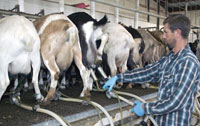Developing improved versions of biological drugs – so-called biosuperiors or biobetters – is set to become the next big trend for biopharmaceutical companies. With legislation for generic biological drugs – biosimilars – lacking (C&I, 2008, 24, 14), many biogenerics firms are seeking alternative strategies and biosuperiors look promising. It is the innovator companies that develop better versions of their own biologics, however, that stand to gain the most from the practice by retaining patients and regenerating patent portfolios.
The advent of biological drugs – manufactured therapeutic proteins – brought with it competition and a desire by some companies to make copycat versions. The idea was that, once agreed by regulators, an abbreviated regulatory pathway would enable companies to develop commercially viable biosimilars. The complexities of biologics, however, has meant that there is no regulatory guidance for biosimilars in the US and, although overarching guidelines are available in the EU, regulators have been slow to detail exactly what is required for the approval of such drugs, which can be subtly but significantly altered by different manufacturing processes.
In November 2010, the European Medicines Agency started a consultation on draft guidelines for biosimilar antibodies, outlining requirements for the approval of such drugs. It was originally thought that companies might be able to extend the clinical data for one indication to all disease indications, but many now expect the agency to demand clinical trial data for each disease indication – too timely and costly for all but the largest generics companies to consider.
‘Unless the biosimilar is based on the simplest biological, it is unclear whether development time will be much shorter,’ says Simon Conway, analyst at Evolution Securities. ‘Rather than traverse the new legislation without full guidelines, a few big pharma companies and, interestingly, also the largest of the generic companies, such as Teva and Sandoz, are looking at developing biobetters as an alternative strategy to biosimilars.‘
‘We believe biosimilars are not going to be as easy as expected and the cost of clinical trials is increasing. So we’re putting money into socalled biosuperiors,’ says Herren Wu, head of biosuperiors and head of antibody discovery and protein engineering at biotech firm MedImmune, which was bought out by AstraZeneca in 2007. MedImmune currently has several biosuperior programmes in early clinical or pre-clinical trials and intends to substantially increase its biosuperior programmes in the near future through internal efforts or in-licensing. ‘In contrast to biosimilars, biosuperiors are innovator products that can bring patients additional clinical benefits,’ says Wu.
Efforts to develop biosuperiors involve modifying successful drugs or de novo discovery of drugs against clinically validated targets to improve a drug’s efficacy, safety or delivery. Although the resulting biosuperior would follow the same regulatory pathway as a totally new drug, the overall development time will likely be shorter because the mechanism of action – the way the drug affects its target – has already been proven during the development of the original drug.

Biosuperiors have proven better than their parent drug
Conversely, some biosuperiors have proven better than their parent drug. Malecki points to Amgen’s Neulasta (pegfilgrastim), for example, a pegylated version of its bone marrow drug Neupogen (filgrastim) that requires fewer injections.
Wu says he expects biosuperiors to be pursued by many companies, particularly biotech firms, which are better at the innovation required to create improved products. However, ‘it is not for everyone,’ he cautions, ‘as my personal opinion is that it still requires a lot of money and showing “superior” differentiation in human trials is not an easy task’.
‘A company would pursue biosuperiors if its business model is to make investments in higher risk products that bring a higher reward,’ explains a Novartis spokesperson. ‘It would also pursue this approach if it has the resources and the mandate to invest significantly more in development than for a biosimilar.’ The biopharma pipeline of Sandoz, the generic arm of Novartis, has eight to 10 molecules at various stages of development.
Fundamentally altering a drug would require a full development programme, which is considerably more expensive than biosimilar development. Moreover, while some proteins, such as insulin, are relatively simple molecules, most biologics are mixtures that have different patterns of glycosylation. And different patterns of glycosylation may improve a drug’s efficacy and safety profile. If these patterns can be identified and the glycoforms selectively manufactured then this represents a potential opportunity to extend or carve out an intellectual property position around the drug. However, controlling glycoforms is at the cutting edge of biological manufacturing, Conway points out.
For these reasons, biosuperiors are more likely to be manufactured by the company that developed the original drug – companies that already have the technology, process controls, data and knowledge to build on and expand an existing patent. ‘With both the original and superior version made by the same company, it is easy to switch patients over to the biosuperior,’ says Malecki. ‘Provided companies have the technology to make them better, [developing biosuperiors is] an easy way to renew patent estates.’
Meanwhile, as some companies develop biosimilars branded as biosuperiors, and others build on innovation, still others are aiming to develop cost-effective biosuperiors using novel technologies.
GTC Biotherapeutics, for example, aims to produce biosuperiors using transgenic technology to produce proteins in the mammary glands of milk-producing mammals, such as goats, cows, rabbits and pigs. GTC ceo William Heiden says the company’s transgenic approach enables it to circumvent patents protecting the use of traditional cell culture technology used by most companies to make proteins.
GTC has developed a version of Rituxan with a slightly higher cell-killing ability than the original. The theory – which must still be proven in clinical trials that are due to start in 2011 – is that it will be more effective. If it works, GTC’s version of Rituxan, which is produced in transgenic animals, could be the killer application of this technology the market has been waiting for, Conway says.
Other companies, meanwhile, refuse to acknowledge biosuperiors per se, pointing out that truly superior drugs are actually innovative drugs. Anton Haselbeck, head of new technologies at Roche Diagnostics, says that Roche, which is not developing biosimilars, is also not pursuing biobetters as a strategy and would only develop a superior version of one of its own drugs if the new molecule showed a clear benefit to the patient, such as fewer injections or improved efficacy. ‘A change in half life will not be enough [for a biobetter] in future,’ says Haselbeck. ‘We would want strong differences and greater medical benefit.‘
Roche has, however, developed pegylated versions of the antiviral Pegasys (interferon-a) and anaemia drug Mircera (erythropoietin) that have improved properties. And although it has a follow-on Rituxan that acts on a different part of the CD20 target, Haslebeck says the company has no true biobetter molecules in development. ‘For an innovator company like Roche, there is no incentive to develop biobetters that are just a little different,’ he says. ‘There must be a difference that makes a difference.’
Emma Dorey is a freelance writer who lives in Brighton, UK.





